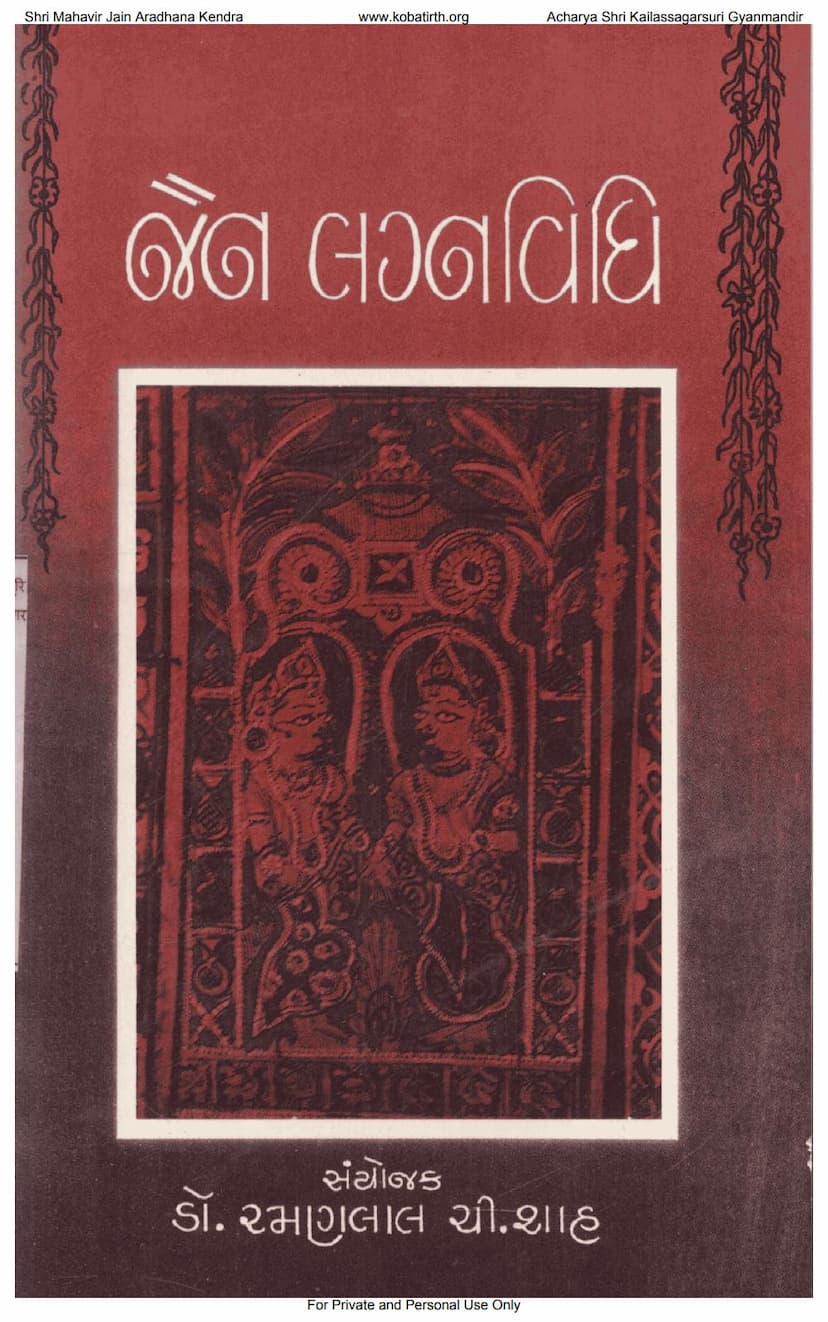Jain Lagna Vidhi
Added to library: September 2, 2025

Summary
Here's a comprehensive summary of the Jain Lagna Vidhi text, based on the provided pages:
Title: Jain Lagna Vidhi (Jain Marriage Ceremony) Author/Compiler: Dr. Ramanlal C. Shah Publisher: Shri Jaybhikkhu Sahitya Trust Edition: Second Edition, 1999
Core Purpose and Philosophy:
This book provides a detailed guide for conducting a Jain marriage ceremony, aiming to align traditional practices with the core principles of Jainism, particularly its emphasis on non-violence (ahimsa) and spiritual progress. The compiler, Dr. Ramanlal C. Shah, explains that Jain scriptures, due to their focus on renunciation and liberation, do not extensively detail marriage rituals. However, he notes that the first Tirthankar, Lord Rishabhadeva, introduced marriage as a way to civilize people. The aim of this Jain Lagna Vidhi is to ensure that the ceremony does not compromise the householder's vows of non-violence and right faith (samyaktva).
Key Features and Content:
- Historical Context: The compiler acknowledges that while the Jain tradition itself emphasizes spiritual pursuits, specific marriage rituals are not as extensively documented as in some other traditions. He references historical figures like Acharya Shrimad Vijayhans Suri and various texts and practices from both Digambar and Svetambar traditions to create a comprehensive and adaptable ritual.
- Modern Adaptability: The Jain Lagna Vidhi is designed to be adaptable to modern times, catering to Jains living both domestically and internationally, and is intended to be acceptable across the four main sects of Jainism.
- Focus on the Wedding Mandap Ceremony: The book primarily focuses on the rituals performed within the wedding mandap. It explicitly states that certain pre-wedding rituals like matru kulkar sthapan, mandap muhurt, varyaatra prasthan, põkhvu, pahirāmani, and kanyā vidāy are not included and can be performed according to the customs of the specific community.
- Mandap Layout and Seating Arrangement: Page 6 provides a diagram illustrating the ideal seating arrangement in the wedding mandap, including the placement of the bride, groom, parents, officiant (vidhikaar), assistants, religious symbols (Siddhachakra Yantra, Jin Pratima, Jin Vani), and ritualistic materials. The bride and groom typically face north, and the officiant faces east.
- Essential Materials (Āvashyak Sāmagrī): Pages 7 and 8 list a comprehensive inventory of materials required for the ceremony. This includes religious items like Jin images or photos, scriptures, and the Siddhachakra Yantra; seating arrangements like bajaths (low stools) and patlas (planks); ritualistic items such as kalash (pots), lamps, incense, camphor, ghee, rice, turmeric, betel nuts, and sacred threads; and decorative items like leaves and flowers.
- Instructions for the Officiant (Vidhikaar): Page 10 offers crucial guidance for the person conducting the ceremony. This includes thoroughly reading the Vidhi beforehand, practicing chants and mantras, planning the seating and material arrangement, understanding the impact of chanting versus singing on timing, and making appropriate adjustments based on the preferences of the bride's or groom's families.
- Mangalacharan (Invocation): The ceremony begins with auspicious invocations, including the Navkar Mantra (Namō Arihantāṇam, etc.) and prayers to the Pancha Parameṣṭhis (Arihants, Siddhas, Acharyas, Upadhyayās, and Sadhus) for auspiciousness.
- Rituals Performed: The book details various rituals, including:
- Ātmarakṣā Mantra (Vajrapañjar Stotra): A protective mantra for self-defense.
- Mangal Tilak and Sthāpanā Vidhi: Applying tilak with kesar-chandan, tying sacred threads (nādāchhaḍī), and offering protection amulets.
- Chatvāri Mangal: Recitation of the four auspicious elements in Jainism.
- Puṣpāñjali: Offering flowers, with an option to use cloves if flowers are prohibited.
- Pujā (Worship): Worship of the Tirthankar Bhagwans, reciting verses and offering dhūp, dīp, akshat, naivedya, and fruits.
- Siddha Pujā (Optional): Worship of the Siddhas.
- Shrut Pujā (Scripture Worship): Worship of the Jin Vani (Jain scriptures).
- Laving Āhuti (Offering Cloves): Offering cloves to specific mantras chanted by the officiant.
- Shānti Mantra and Abhiṣek: Chanting a peace mantra and sprinkling holy water.
- Kanyāpradān Vidhi (Giving Away the Bride), Varaṇ Vidhi, Gotroccār: Formal rituals where parents give away and accept the bride and groom, often involving stating lineage and intentions.
- Chheḍābandhan (Tying of Garments): Tying the ends of the bride's and groom's garments together, symbolizing their union.
- Hastamelāp (Joining of Hands): The ceremonial joining of the bride's and groom's hands.
- Seven Vows (Saptapadī): The couple takes seven vows, promising fidelity, family integration, mutual support, shared journey through happiness and sorrow, respect for elders, equal partnership, and adherence to Dharma, Artha, and Kama.
- Mangal Phērā (Auspicious Rounds): The couple circumambulates the sacred fire or the altar three times, symbolizing their commitment.
- Nirvāṇa Paramsthān Pujā: Worship of the ultimate state of liberation.
- Blessings and Vāskṣep: The officiant blesses the couple with grains and recites auspicious phrases.
- Visarjan (Farewell): A ritual of seeking forgiveness for any errors and bidding farewell to the divine presence.
- Aarti, Mangal Dīvo, Shānti Pāṭh, Chaitya Vandan: Post-ceremony rituals for peace and auspiciousness, including devotional songs and prayers.
Overall Significance:
"Jain Lagna Vidhi" serves as a vital resource for the Jain community, providing a structured and spiritually grounded framework for marriage ceremonies. It emphasizes the integration of religious principles into a significant life event, ensuring that the union is blessed and aligned with the tenets of Jainism, promoting a virtuous and harmonious married life. The book reflects a thoughtful effort to adapt ancient traditions for contemporary relevance while upholding the spiritual essence of Jainism.